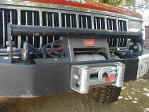
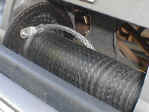
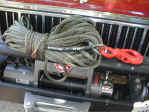

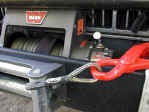
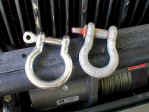


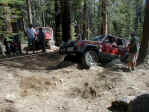

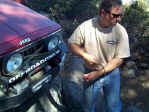

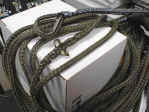
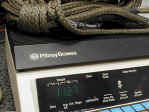
X-Line Recovery Gear from Off Road Only
Upgrading to a synthetic winch rope was a high priority for me, so I was especially interested in X-Line, a new and different kind of synthetic rope from Off Road Only. X-Line is similar to the Master-Pull product with some improvements, most notably its much higher resistance to heat. The X-Line has been fabulous and is everything I hoped it would be. It's strong, safe and extremely light weight. I've done a lot of research on synthetic rope, and I'll share my findings with you here.
The first synthetic winch rope replacement product to be seen a few years ago was Ultra-High Molecular Weight Polyethylene, or UHMWPE. Depending on who's selling it, it's also called AmSteel Blue, Plasma Rope, and Master-Pull. X-Line isn't just another name for the same stuff; it's a totally different product. X-Line is similar to UHMWPE in a lot of ways, but it's differences make it stand out. We'll discuss some of the important features and compare them to steel. I think you'll agree synthetic rope in general, and X-Line specifically, is worth putting on your gift list.
Is This Rope for Real?
A lot of people are hesitant to replace their steel cable with this strange, new stuff. Blue? Yellow? Purple? Green? It looks like a joke! Some say it's not as tough... that the synthetic rope will fray easily and break. Others worry that it's plastic and that heat from the winch will melt it. Price conscience guys have trouble with the high cost. These are valid concerns, but there are good answers.
Tough Stuff
Does synthetic rope fray and break? Yes, but not any more than a steel cable. In many cases, the synthetic stuff can be abused far more than steel and still be safe. Have you ever kinked a steel cable? Of course! Every kink in a steel cable adds a serious weak point to an already dangerous product. The synthetic rope doesn't care how it's bent, kinked or abused. It's tough and it bounces right back into shape. Some fraying is to be expected, but the strength is reduced only incrementally compared to the huge number of fine fibers. Previous testing by 4x4Wire showed the synthetic rope actually wearing away the edge of a steel fairlead!
Sure, it's tough, but why wear the rope when it's not necessary? A nifty wear guard can be had when purchasing the X-Line. ORO's version can be taken on and off thanks to a full-length velcro edge. Some people take their guard on and off, but I leave my wear guard on all the time. It simply rolls up inside the winch, protecting the end of the X-Line even when the winch isn't being used.
Heat
Will the plastic rope melt on a hot winch drum? Yes or No, depending on which product you're talking about. Heat is a real concern, but only with the UHMWPE, which has a melting temperature of 284º F, and a critical temperature (the point at which the rope starts to weaken) of only 150º F. The drum of a Warn winch can be expected to reach temperatures well over 200º F (one source says as high as 300º F). The Technora aramid fiber-based X-Line rope does not begin to decompose until over 900º F, and X-Line can be used at nearly 400º F for long periods of time without loss of strength. At last, a winch product that doesn't have heat as an Achilles heel!
Sun Damage
Untreated, both UHMWPE and X-Line will degrade in the sun and can lose as much as half their strength when exposed to direct sun for three months. Both products, however, are coated with a UV polyurethane protective coating. I'm keeping my winch line out of the sun whenever possible, but X-Line's coating will protect it. The untreated X-Line is yellow... about the same color as a sticky note. (The original color can be exposed by pulling apart the fibers.) The UV coating turns it a nice dark green.
Rope Length and Extension
I opted for a 100' rope for my winch, compared to the standard 125' steel cable that ships with the XD9000i. With the shorter length, I can winch closer to the drum, giving me a better pull... more pounds with fewer electrical amps. Less rope on the drum also means I can bunch it up during a side pull without worrying about jamming the drum. If I need more cable, I reach for the 50' winch extension. I can use the extra piece for either increased line length for myself or for other guys who still have the steel cable. By using my synthetic X-Line on the end of a steel cable, we can unspool less steel, reducing the chance of a broken-cable injury.
Rope Elongation and the Stretch Myth
Winch cable backlash is a major concern for anyone working with it or close to it. A broken steel cable can be deadly. Why? We've all heard the same thing, that steel is dangerous because it stretches. And that synthetic rope, either UHMWPE or X-Line, is safe because it does not stretch. Correct? I don't think so. The danger from steel cable comes from its weight, not the stretch.
Steel stretches... as much as 1.7% elongation at break, but that's less than synthetic. Compare that to X-Line's 4.6% elongation at break (14,000 lbs. for the 5/16" dia. rope). That would make X-Line more dangerous, but it isn't. Let me dust off some book learnin' from way back. Energy is mass times velocity squared, E=MV². The weight (M) plays a direct (not squared) role in the energy equation. The velocity (V) of the rope is a bigger factor because it's squared, yet the lighter rope just drops dead on break. There must be a physical property we're not considering. How about... what's it called... snap? Snap factor. How quickly does the elongated mass return to its original dimension when the tension is released? I'll wager steel returns to its original length almost instantly, which would create a massive acceleration in a large mass. Synthetic rope (educated guessing here) probably returns slowly. The slow acceleration and light weight create no energy. The rope drops harmlessly.
The notion that synthetic rope does not stretch has a basis in truth, I think, when compared to traditional nylon and polyester ropes. Those old-technology products have much higher stretch figures and vastly lower strengths.
UHMWPE differs here, because it stretches less than X-Line. UHMWPE has an elongation of only 0.79% at 30% of breaking strength (that's about 4,200 lbs. pull). X-Line's stretch is 1.2% at the same tension, or about 50% higher. Is the additional stretch a problem? Probably not. Remember that the synthetic rope has a much higher breaking strength than steel, so the large amount of stretch will not be seen in real life.
Weight
Wow, what a weight savings! The steel cable weighs 23 lbs compared to 3.5 lbs for the 100' X-Line replacement rope. Check out the image of Little B holding up the 50' extension with his little finger! X-Line is a dream to work with on the trail. In a place like Pritchett Canyon, where a group member can be in one spot winching for a couple of hours, it can't be beat. You can work right next to it while winching. Most people end up working in the danger zone anyway, in spite of the danger of steel, so X-Line is a big help. The light line (almost too light!) can be easily flicked to the side of the trail until the next person needs it.
As long as we're talking about weight, it's interesting to note that UHMWPE floats, but X-Line's specific gravity of 1.39 means that it won't be as popular with ocean-going types. That's no loss for me, but wakeboarders will be staying with their 1/8" HMWPE lines.
Switching Cables
Changing cables was a simple task. I unspooled the steel and disconnected it from the drum. The end of the cable is held in place with a small hex bolt. Don't winch from the attach point! There need to be a bunch of wraps around the drum before winching can begin. It's the friction of the cable against the drum that takes the tension, not the little bolt. Thread the X-Line through the fairlead and attach it to the drum in the same way as the steel cable. The X-Line's awesome steel safety hook can't be threaded through the fairlead, so changing fairleads (like I did later on) requires totally removing the rope. No big deal. The X-Line was super simple to work with. There's no need to worry about splinters and the light weight rope can be easily maneuvered without gloves.
I was careful to lay down a smooth first wrap, which is no problem. X-Line has a rectangular shape, so it packs nicely. After the first tight layer, you'll need to either continue wrapping tightly or begin wrapping diagonally. A loose semi-straight wrap will create air gaps into which subsequent wraps will fall and get caught. Like with steel, you probably won't be able to free-spool them out. After the first wrap, I continued the tight wrap until the last bit when I switched to a diagonal wrap. I fed the wear guard into the fairlead and wrapped on the drum, leaving just enough out to protect the end of the rope. It looked fine and worked great. After a number of pulls, the line isn't as neat. In fact, it's downright ugly! In spite of what looked like permanent damage to the line... all crushed, tweaked and bent... it unspools and returns to its original shape without effort. Amazing.
Re-coiling the original steel cable was the trickiest part of the job! It's hard to coil flat because it's heavy and thin. I secured it in three places with wire and gave it to a fellow SLO 4-Wheeler. Mark's steel winch cable was badly kinked from a difficult righting job we had on a trip early in the summer. His CJ-7 tipped on a local trail, and getting it back on all four required a torturous cable routing job through his frame and out the side. It was ugly, but it worked. It would have been interesting to try the same thing with X-Line, but we hope to never be in that predicament again!
Hooked for Life
The X-Line rope is a dream to work with. It's light and soft. There's no chance of the deadly steel-cable-backlash, so you can work right next to the rope while helping your friends get unstuck. I've got the thinner version of the rope, but it's still stronger than the steel predecessor. The 100' length is shorter, but that helps the winch by pulling closer to the drum. I've got the 50' extension if I need more length. The protective rubber sheath is tearing a bit, but that's its job... to protect the rope. The the Italian made German-tool-steel safety hook is great. It's used differently than a standard open hook, but once you're used to it, you won't go back.
About Off Road Only
I met the Off Road Only guys in Moab, Utah at Easter Jeep Safari 2002 and enjoyed their booth more than most others. They are nice people with innovative products. In addition to their X-Line winch rope replacement product, they market LED rock lights, adjustable air suspensions and lots more.
Rope Comparison: UHMWPE vs. X-Line
Industry Figure | Berkeley | Jeep Cherokee | Back to Recovery Gear